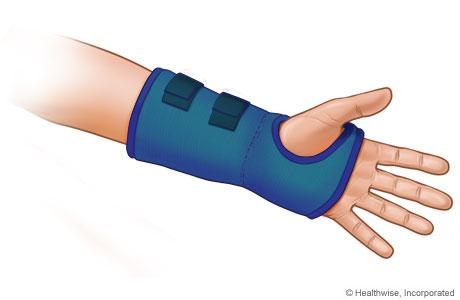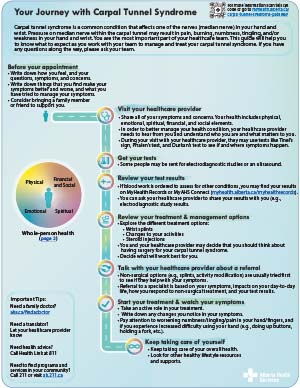There are a few treatment options available for carpal tunnel syndrome. Many of these treatments can be done at home. For some people, symptoms may resolve in about 6 months, especially if you are under 30 or have not had carpal tunnel syndrome symptoms for very long.
Medicines are not typically used to treat carpal tunnel syndrome as they may cover up your symptoms and delay treatment. Your healthcare provider might suggest medicines to help manage pain after you and your healthcare team have decided that you will be going for surgery.
Wrist splints

Wrist splints are often used to help manage carpal tunnel syndrome. Splints work by supporting your wrist in a neutral position (not bent). It is important that you choose a splint that is long enough to support your wrist in a neutral position. Your healthcare provider may recommend when and how long to wear your splint (for example, while sleeping and when doing activities that make your carpal tunnel syndrome worse).
You can buy wrist splints at most pharmacies. The cost of a wrist splint may be covered by private insurance plans. If you are worried about the cost of a wrist splint, talk with your healthcare provider.
Most people do not mind wearing a wrist splint, but if the fit and feel of your splint makes it hard for you to wear, let your healthcare provider know. They may have other options available.
Changes to your activities
Your healthcare provider will ask if you can reduce or stop doing any activities that make your symptoms worse.
If you can’t change your activities, like if the activity is part of your job or something you need to do to care for yourself, let your healthcare provider know. They may be able to offer different supports, like suggesting equipment to help you during your activities.
Steroid injections
Local
corticosteroid injections work by decreasing swelling and inflammation. This treatment can help reduce pain and increase your ability to use your hands for a period of time. Steroid injections are most effective when they are done along with changes to the activities that affect your carpal tunnel symptoms. Steroid injections can sometimes be done by your primary care provider in their office or they may refer you to a specialist for ultrasound-guided steroid injections.
Your healthcare team will monitor how much symptom relief you get from a steroid injection and how long any relief lasts. If symptoms do not improve or if they return after 1 steroid injection, other treatment options should be considered. You should not receive more than 3 carpal tunnel steroid injections in your lifetime as this is unlikely to improve symptoms long term and may delay other treatments leading to more permanent damage. If you are going for surgery, it is important that you not have a corticosteroid injection for at least a month before your surgery.
Surgery
You and your healthcare provider may decide that you should think about having surgery to treat your carpal tunnel syndrome. Surgery may be a good option if:
- you have had symptoms for a long time
- other treatments haven’t helped
- your tests show that you have nerve damage
- your symptoms impact your day-to-day life significantly
The surgery for carpal tunnel syndrome is called a
carpal tunnel release. During the surgery, the surgeon will cut a ligament to release pressure on your median nerve.
For decision aids to help you decide between treatment options, see:
Other treatments
The use of alternative therapies has not been proven to effectively treat carpal tunnel syndrome. Alternative therapies may include active release therapy, thermal therapy, transcutaneous electrical stimulation, shockwave therapy, low level laser, massage therapy, and acupuncture.

Carpal Tunnel Syndrome Pathway
Download or print the
full patient pathway (PDF) and
summary (one-page PDF) to learn more about how to manage and treat Carpal tunnel syndrome.
Patient Pathway  Summary
Summary 
